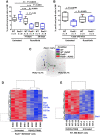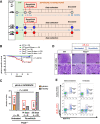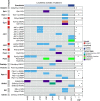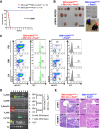Transient Inhibition of the JAK/STAT Pathway Prevents B-ALL Development in Genetically Predisposed Mice
- PMID: 35131871
- PMCID: PMC9359729
- DOI: 10.1158/0008-5472.CAN-21-3386
Transient Inhibition of the JAK/STAT Pathway Prevents B-ALL Development in Genetically Predisposed Mice
Abstract
Preventing development of childhood B-cell acute lymphoblastic leukemia (B-ALL), a disease with devastating effects, is a longstanding and unsolved challenge. Heterozygous germline alterations in the PAX5 gene can lead to B-ALL upon accumulation of secondary mutations affecting the JAK/STAT signaling pathway. Preclinical studies have shown that this malignant transformation occurs only under immune stress such as exposure to infectious pathogens. Here we show in Pax5+/- mice that transient, early-life administration of clinically relevant doses of ruxolitinib, a JAK1/2 inhibitor, significantly mitigates the risk of B-ALL following exposure to infection; 1 of 29 animals treated with ruxolitinib developed B-ALL versus 8 of 34 untreated mice. Ruxolitinib treatment preferentially targeted Pax5+/- versus wild-type B-cell progenitors and exerted unique effects on the Pax5+/- B-cell progenitor transcriptional program. These findings provide the first in vivo evidence for a potential strategy to prevent B-ALL development.
Significance: JAK/STAT inhibition suppresses tumorigenesis in a B-ALL-susceptible mouse model, presenting a novel approach to prevent B-ALL onset.
©2022 The Authors; Published by the American Association for Cancer Research.
Figures





References
Publication types
MeSH terms
Substances
Grants and funding
LinkOut - more resources
Full Text Sources
Molecular Biology Databases
Research Materials
Miscellaneous

